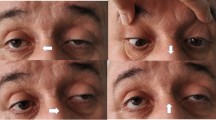Abstract
Background
The purpose of this study was to describe the treatment experiences and outcomes of patients with myasthenia gravis (MG) whose initial presenting symptom was diplopia
Methods
A retrospective review was performed on a group of patients with MG whose initial presenting symptom was diplopia.
Results
The mean age of onset was 45.5 ± 16.9 years, and the mean follow-up period was 45.4 ± 39.7 months. Exotropia with vertical heterotropia was the most common type of deviation. The mean horizontal deviation was 20.1 ± 17.9 prism diopters, and the mean vertical deviation was 14.8 ± 11.1 prism diopters. Limitation of eye movement was found in 20 patients (71.4 %) during the follow-up period. After conventional treatment for MG, six patients (21.4 %) showed a good response with resolution of diplopia. Four patients (14.3 %) showed a partial response to treatment. Eighteen patients (64.3 %) showed minimal or no response; among them, ten (35.7 %) had an angle of deviation of 15 prism diopters or more. Six patients underwent strabismus surgery. Four were symptom free, and satisfactorily aligned after surgical treatment. One patient had intermittent diplopia despite the small amount of deviation, and one patient experienced recurrence of exotropia with diplopia during the 10-year follow-up. In multivariable analysis, the only factor associated with the need for strabismus surgery was the initial angle of deviation (p = 0.016).
Conclusions
Patients with MG who have a larger angle of deviation at presentation tend to require strabismus surgery after stabilization of the disease. Strabismus surgery is one treatment option for patients with MG who have a large angle of deviation and respond poorly to conventional treatment.



Similar content being viewed by others
References
Seybold ME (1983) Myasthenia gravis. A clinical and basic science review. JAMA 250:2516–2521
Conti-Fine BM, Milani M, Kaminski HJ (2006) Myasthenia gravis: past, present, and future. J Clin Invest 116:2843–2854
Vincent A, Palace J, Hilton-Jones D (2001) Myasthenia gravis. Lancet 357:2122–2128
Glaser JS, Siatkowski RM (1998) Infranuclear disorders of eye movement. In: Tasman W, Jaeger EA (eds) Duane’s clinical ophthalmology. Lippincott Williams & Wilkins, Philadelphia, p 36
Kaminski HJ, Maas E, Spiegel P, Ruff RL (1990) Why are eye muscles frequently involved in myasthenia gravis? Neurology 40:1663–1669
Bentley CR, Dawson E, Lee JP (2001) Active management in patients with ocular manifestations of myasthenia gravis. Eye (Lond) 15:18–22
Ohtsuki H, Hasebe S, Okano M, Furuse T (1996) Strabismus surgery in ocular myasthenia gravis. Ophthalmologica 210:95–100
Davidson JL, Rosenbaum AL, McCall LC (1993) Strabismus surgery in patients with myasthenia. J Pediatr Ophthalmol Strabismus 30:292–295
Morris OC, O’Day J (2004) Strabismus surgery in the management of diplopia caused by myasthenia gravis. Br J Ophthalmol 88:832
Acheson JF, Elston JS, Lee JP, Fells P (1991) Extraocular muscle surgery in myasthenia gravis. Br J Ophthalmol 75:232–235
Ekdawi NS, Nusz KJ, Diehl NN, Mohney BG (2009) Postoperative outcomes in children with intermittent exotropia from a population-based cohort. J AAPOS 13:4–7
Cogan DG (1965) Myasthenia gravis: a review of the disease and a description of lid twitch as a characteristic sign. Arch Ophthalmol 74:217–221
Weinberg DA, Lesser RL, Vollmer TL (1994) Ocular myasthenia: a protean disorder. Surv Ophthalmol 39:169–210
Barton JJ, Fouladvand M (2000) Ocular aspects of myasthenia gravis. Semin Neurol 20:7–20
Kim JH, Hwang JM, Hwang YS, Kim KJ, Chae J (2003) Childhood ocular myasthenia gravis. Ophthalmology 110:1458–1462
Kusner LL, Puwanant A, Kaminski HJ (2006) Ocular myasthenia: diagnosis, treatment, and pathogenesis. Neurologist 12:231–239
Financial support
None
Conflict of interest
None of the authors have any conflicts of interests with regard to this research.
Author information
Authors and Affiliations
Corresponding author
Additional information
Authors have full control of all primary data, and agree to allow Graefe’s Archive for Clinical and Experimental Ophthalmology to review the data upon request.
Rights and permissions
About this article
Cite this article
Park, KA., Oh, S.Y. Treatment for diplopia in patients with myasthenia gravis. Graefes Arch Clin Exp Ophthalmol 251, 895–901 (2013). https://doi.org/10.1007/s00417-012-2227-x
Received:
Revised:
Accepted:
Published:
Issue Date:
DOI: https://doi.org/10.1007/s00417-012-2227-x




